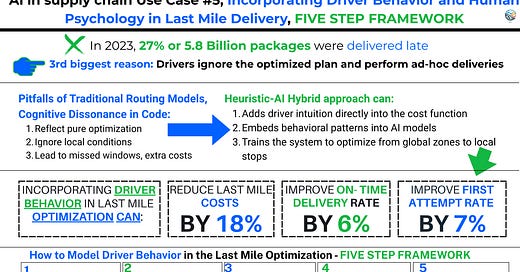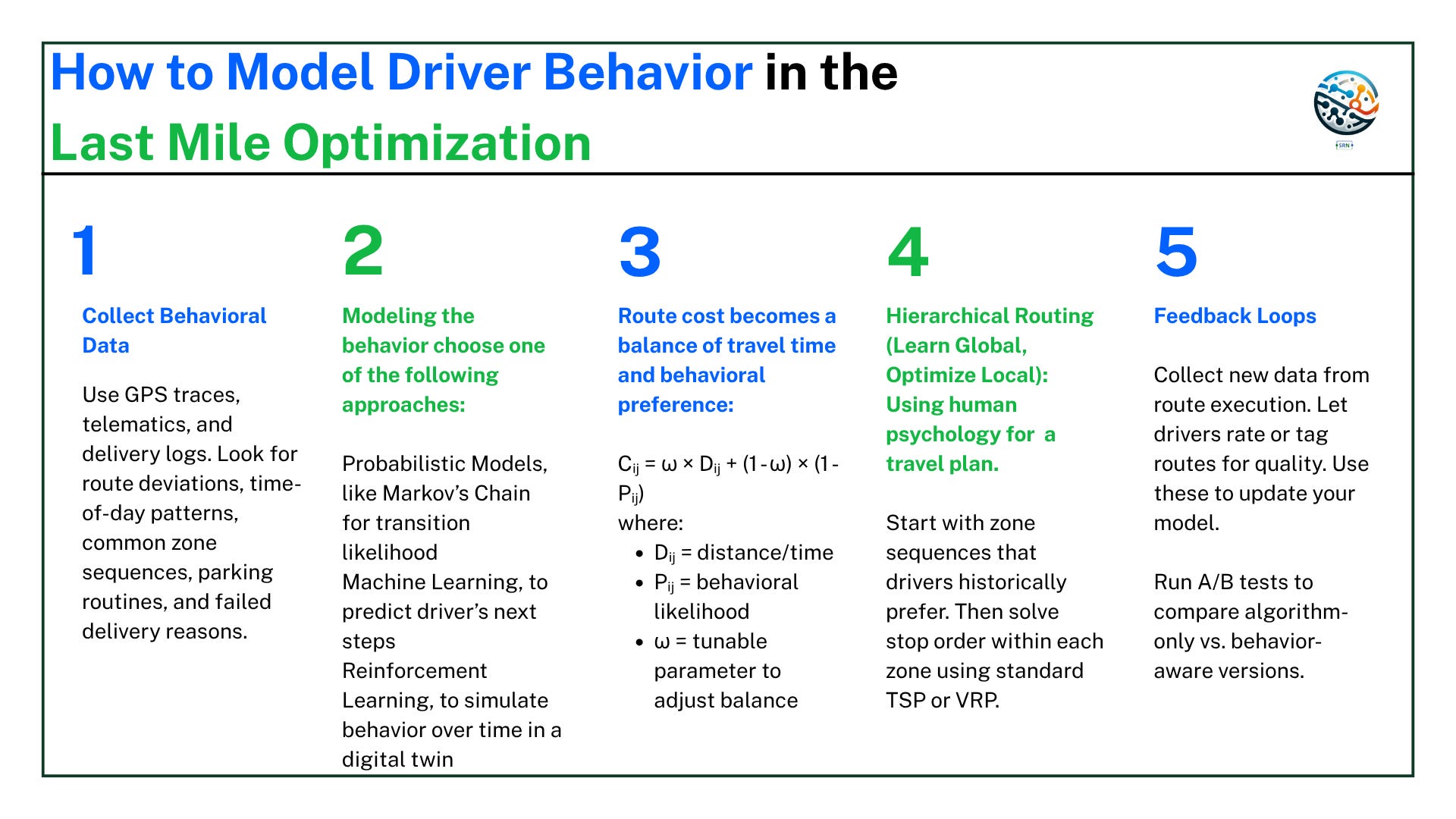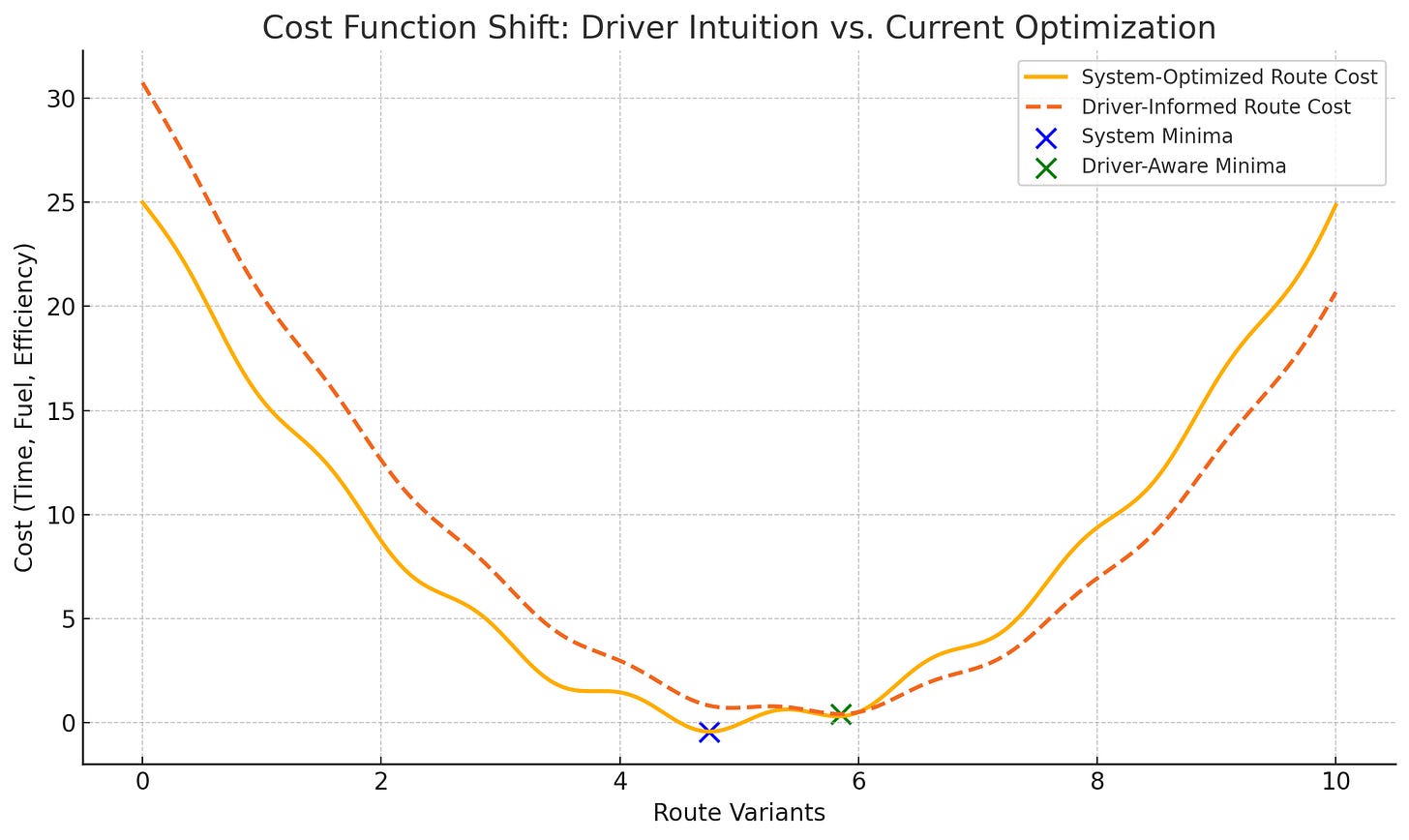Driver Behavior in Last-Mile Delivery: Why Route Optimization Fails Without Human Insight, AI Use Case #5 in Supply Chain
Explore a 5-step framework on how integrating driver behavior into routing algorithms reduces delivery costs, improves efficiency, and builds customer trust in last-mile logistics.
Hey, Nikhil here—welcome to The Silk Road Nexus. Twice a week, I unpack what’s shaping the world of supply chain—from deep dives on strategy and optimization to real stories from the frontlines of global commerce.
If this is your first read, you’re right on time to join a growing circle of operators, thinkers, and builders reimagining how the world moves.
“AI in Supply Chain Management” is an ongoing series where I explore not just current applications, but future opportunities for AI across the supply chain. Discover other use cases here.
This essay focuses on a fifth use case for AI in logistics: embedding human behavioral patterns into routing models.
🔑 Top 5 Key Takeaways
Route deviations drive up to 12% of last-mile costs, and this figure is rising with growing e-commerce volume and urban congestion.
Driver behavior is context-aware and often more efficient locally than system-generated routes, but current algorithms fail to capture this nuance.
Traditional routing models like TSP are computationally rigid and behaviorally misaligned. They struggle to scale and ignore how humans think in zones, not stops.
Heuristic-AI hybrid models offer the best near-term solution, embedding driver behavior into cost functions and using zone-based planning for realistic, adaptive routing.
Behavior-aware routing delivers real business impact—up to 11% cost savings, 5% faster routes, 6–7% better on-time delivery, and 25% fewer service escalations per 1,000 deliveries.
📍 The Problem: Deviation from Planned Routes
The biggest and most persistent cost driver in last-mile delivery is deviation from planned routes. This accounts for up to 12% of total last mile expense. With e-commerce parcel volume increase by over 25%, since 2020, and urban congestion increasing annually, this figure is expected to climb unless behavior-aware routing is adopted.
This presents an opportunity in last mile, by embedding driver feedback into routing models, logistics providers can bridge this gap and unlock significant operational gains.
Strategic Gains from Driver-Informed Optimization:
💰 Cost Savings: Up to 9–11 percent reduction in last-mile delivery costs per 1,000 deliveries, through reduced fuel use, fewer manual interventions, and shorter route times.
⏱️ Time Efficiency: Routes that align with driver behavior are 5 percent faster, allowing more deliveries per route and reducing labor costs.
📦 Delivery Reliability: Integration improves on-time delivery rates by 6–7 percent, leading to stronger customer trust and higher retention.
📉 Operational Overhead: Up to 250 minutes saved per 1,000 deliveries in administrative re-routing and exception handling.
📞 Customer Experience: Reduces customer service escalations by 25 percent, minimizing cost-to-serve.
🔍🌊 Deep Dive into the Issue
Drivers hold local, situational knowledge that routing algorithms ignore. Drivers know which buildings are difficult to access, when school traffic hits, and where road closures happen. These insights shape local decisions that override system-generated routes.
Amazon identified a significant operational gap where delivery drivers frequently deviated from system-generated routes. This issue was first flagged at the executive level, where Amazon’s VP of Last Mile observed that such deviations led to inconsistencies in delivery performance, increased cost variability, and customer dissatisfaction.
The company initiated data collection across tens of thousands of routes to understand the behavioral patterns behind these deviations, confirming that system-optimal routes often conflicted with driver instincts shaped by local knowledge and real-world constraints
As I understand, drivers do not dismiss optimized routes out of carelessness. They do it because those routes ignore lived reality.
While deviations may be rational, they come at a cost: missed delivery windows, failed first-attempt deliveries, higher fuel use, and extra labor hours.
These inefficiencies compound, weakening customer trust and damaging the brand. Ultimately, they reduce customer lifetime value.
System-generated routes are 18 percent cheaper and 5 percent faster than those selected by drivers, according to field experiments referenced in the 2023 study published in Transportation Research Part B: Methodological.
Still, not all deviations are harmful. Many reflect smarter local decisions. A driver who knows a certain street clogs with school traffic at 3 PM will reroute ahead of the delay. That judgment, grounded in experience, can outperform pure optimization.
The goal is pass this judgement to machines.
❗ Why Route Optimization Falls Short
The real issue is not route complexity. It is the failure to integrate human behavior into algorithmic decisions.
Cognitive Dissonance in Code: Human vs. Machine Decision Logic
Psychologically, humans follow a global to local navigation approach. Global planning decides what regions to visit and in what order (macro-level). Then local planning determines how to best complete the task.
This is intuitive for humans. We first sketch a rough path (e.g., "First downtown, then uptown") and then worry about detailed turns or stop orders within those areas.
Algorithms think in terms of stops and then cluster them into zones (usually a zip code or a combination of zip codes).
Machines do not explicitly separate local and global layers.
Every stop is treated as part of the same optimization set with the objective to minimize the single global cost function.
This flat approach assumes that all stops are equal and interchangeable, focusing purely on minimizing distance or time.
It does not naturally account for how humans perceive geography.
Modern systems already adjust for traffic, weather, and road conditions. But they omit driver habits, preferences, and local intuition.
This gap creates a blind spot that drains operational efficiency.
Drones and autonomous robots may eventually reduce this problem. But their impact is at least a decade away.
Even then, human reasoning will matter in edge cases and unpredictable conditions.
🧭 Understanding Routing Models
To integrate driver behavior into AI, we first need to understand how routing models work.
Most systems rely on the Traveling Salesman Problem (TSP). TSP finds the shortest route that visits each stop once and returns to the origin. It focuses on minimizing total travel time or distance.
More advanced models like the Vehicle Routing Problem (VRP) extend this to multiple vehicles and additional constraints such as delivery windows.
Nearest Neighbor heuristics use a simple greedy method: always choose the closest next stop. While fast, this often produces zigzagging, inefficient paths.
Loop optimization adjusts classic models to generate circular routes that mimic real driving flows. These are more intuitive and familiar to drivers.
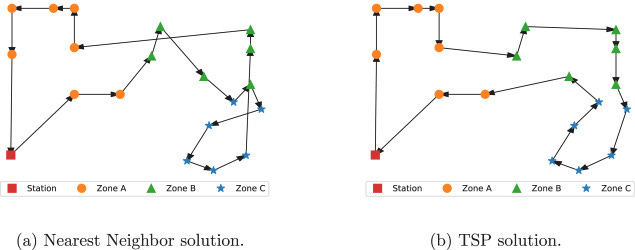
Still, all these models treat routing as a flat optimization problem. They do not mimic how humans plan.
People start with a rough regional plan, then refine within those zones. Algorithms, by contrast, optimize individual stops and only afterward cluster them into zones. This ignores how geography and cognition work together.
⚠️ The Limits of Traditional Optimization through The Traveling Salesman Problem
TSP is limited and is NP-hard, meaning it becomes exponentially more complex as stops increase.
What Does NP-Hard Mean?
NP stands for "Nondeterministic Polynomial time."
A problem is NP-hard if no known algorithm can solve it quickly (in polynomial time) as the input size grows.
The Traveling Salesman Problem (TSP) is NP-hard because:
The number of possible routes is (n-1)! / 2 for n stops.
That grows extremely fast. For just 20 stops, there are 60+ billion possible routes.
For 100 or more stops, real-time optimization becomes impractical. TSP assumes a static environment. It struggles with traffic changes, access delays, and rerouting on the fly.
That’s why companies don’t plan at the stop level anymore. Instead, they group stops into zones, like neighborhoods or regions, and then figure out the best route within each zone. This is much faster processing, and it actually matches how drivers think. See an example below of how zone + stop combination looks like. (data from Amazon, published by “Wu, M., Chen, Z., & Bimpikis, K. (2023). The Cost of Ignoring Human Behavior in Last-Mile Delivery Routing. Transportation Research Part B: Methodological, 175, 103664.”
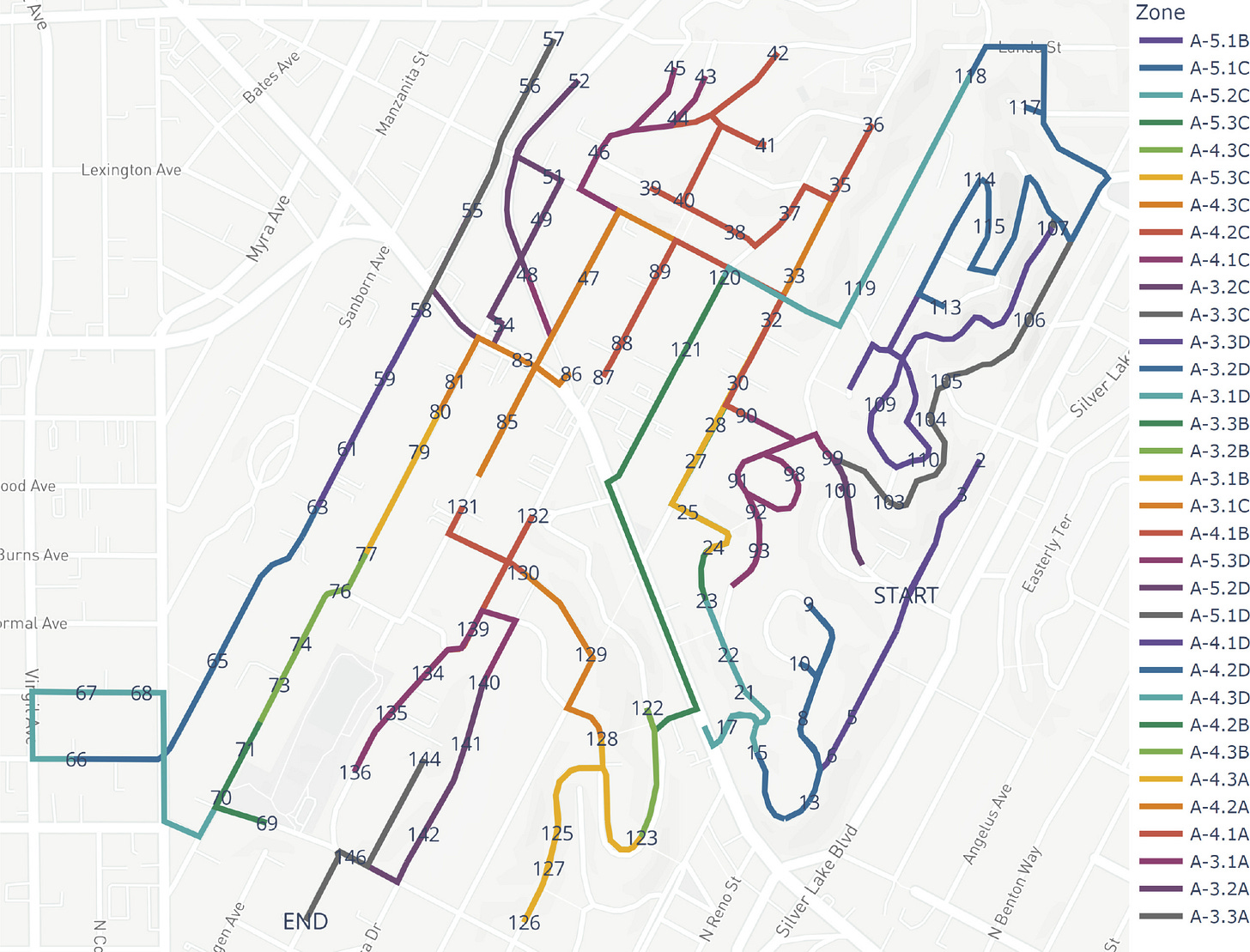
But, TSP lacks behavioral alignment. Drivers prefer to plan by zones, not by flat lists of stops. Algorithms that ignore this create plans that feel foreign, encouraging deviation.
Also, many route planning systems don’t account for how drivers actually behave. Drivers often avoid traffic, skip tricky buildings, or follow familiar paths. So even if the computer picks the shortest path, drivers may not follow it if it feels wrong.
In a nutshell, A full stop-level TSP is too rigid, too slow, and too detached from driver behavior. A zone-based, hierarchical model is computationally feasible, behaviorally aligned, and adaptable to real-world constraints.
💸 Cost of Scaling with Compute
How Scaled Compute Can Partially Address Driver Behavior:
Higher Granularity of Real-Time Data
With more compute, systems can process live traffic, delivery attempts, weather, and route deviation data at higher frequency.
This allows dynamic rerouting that mimics some of what drivers do manually.
Scenario Simulation at Scale
More compute enables the simulation of thousands of “what-if” route scenarios.
Some of these simulations will inadvertently mirror what experienced drivers would do - such as avoiding high-risk areas during school pickup hours.
Faster Feedback Loops
Compute allows faster ingestion and retraining of models with route deviation logs.
Over time, this may allow the system to recognize patterns, but it’s still retrospective, not anticipatory.
Why It Doesn’t Fully Solve It:
Driver decision-making is not just data-driven, it includes intuition, visual cues, and soft constraints (e.g., where to park safely).
Scaling compute doesn’t teach the system why a driver rerouted, it just learns that a deviation occurred.
Compute doesn’t eliminate the "cold start" problem for new routes, drivers, or geographies where no data exists yet.
Trust and compliance issues remain, even highly optimized routes may be ignored if drivers feel their input is missing.
Further, Scaling up brute-force optimization is costly.
Solving last-mile routes with standard TSP costs $10K to $30K monthly in cloud infrastructure. GPU-accelerated heuristics raise that to $50K to $150K.
Reinforcement learning-based optimization can exceed $500K monthly. Even edge-cloud hybrids need both data center and device investment.
Infrastructure Cost Estimate (Monthly, at Scale)
💡 These figures assume use of public cloud infrastructure like AWS, Azure, or GCP and are based on 100–500 concurrent vehicles across multiple cities.
⚖️ Strategic Trade-Off
Building a compute-only last-mile routing engine at scale would cost hundreds of thousands per month and still struggle with driver compliance and real-time volatility.
The best path is a hybrid infrastructure that blends modest compute with AI, driver behavior modeling, and localized refinement.
NOTE: While compute can reduce the symptoms of human misalignment through volume and speed, it cannot understand or replicate behavioral nuance without a dedicated behavioral modeling layer. To truly optimize, the solution must blend scaled compute with behavior-aware cost functions and feedback systems.
Quantum Computing: Promise and Limits
Quantum computing offers promise. It can explore many route combinations in parallel and solve QUBO-formulated routing problems.
Companies like D-Wave and Volkswagen have tested it. But quantum systems remain noisy and limited.
Few can handle more than 100 variables. No real-world deployment yet supports national-scale logistics.
Compared to heuristic-AI hybrid models, quantum computing remains largely theoretical in logistics.
While hybrids already offer real-time behavior-aware optimization at manageable cost and scale, quantum systems are still in experimental stages.
Until error correction and scalability improve, the practical advantages of quantum remain speculative for last-mile applications.
Quantum may become viable in 5 to 10 years. Until then, heuristic-AI hybrid models are the best path forward.
These systems use zone-based heuristics aligned with driver cognition. They embed driver behavior into route cost functions. They support real-time refinement and scale cost-efficiently.
✅ Heuristic-AI Hybrid: The Pragmatic Solution
The best path today is a heuristic-AI hybrid model. These models combine computational efficiency with real-world adaptability.
They use zone-based heuristics aligned with how drivers think. They embed driver behavior into routing cost functions using machine learning or reinforcement learning. They enable real-time, localized optimization without overwhelming infrastructure.
This approach scales well, aligns with human decision-making, and encourages driver compliance.
These models adjust cost functions to include a behavioral alignment term. The optimizer then balances travel efficiency with behavioral likelihood.
Hierarchical models go further. They plan global zone sequences first, then optimize routes within each zone. This mirrors how drivers navigate.
Feedback loops help refine the system. Every executed route improves the model with new data.
🧱 How to Model Driver Behavior
Integrating driver behavior begins with data. Use GPS logs, route deviations, delivery timing, and access constraints to build a historical view.
These inputs train behavioral models using Markov chains, supervised learning, or reinforcement learning.
The goal is not just prediction. It is to embed preference into the routing engine itself.
By modifying the cost function, systems stop optimizing purely for time. They start optimizing for acceptance and execution as well.
🛠️ Implementation Steps
🌐 Bonus: Integrate Real-Time Context
Layer real-time data such as:
Traffic
Weather
Customer availability
Building access windows
Together with behavioral models, this creates adaptive, context-sensitive routing.
Outcome
System-Optimized Route Cost (blue): Finds a sharp global minimum, but ignores practical nuances.
Driver-Informed Route Cost (green): Recognizes smoother, more feasible routes that align better with real-world experience.
The shift in minima demonstrates how embedding driver intuition can lead to more adaptable and execution-friendly optimizations, even if the absolute cost isn't the lowest theoretically. This is especially useful when minimizing delivery errors, failed attempts, or friction with human behavior.
🚧 Challenges in Behavioral Integration
Despite its potential, behavior-aware routing is not without challenges.
Not all driver habits are optimal. Some may reflect outdated routines or personal bias. Overfitting to such behavior can reinforce inefficiencies.
Behavioral data is also incomplete. GPS logs do not capture driver intent. Understanding context requires richer feedback.
Scaling these models across fleets or geographies is complex. Different cities and driver populations introduce variation.
There is a cold-start problem. New drivers or regions lack the data to guide behavior-aware systems effectively.
Finally, even if routes are behavior-aligned, adoption depends on trust and communication. If drivers don't understand or believe in the model, they may still deviate.
🏢 Industry Adoption and What Small Businesses Can Do
Leading logistics players are starting to bridge this gap.
Amazon's Last Mile team uses AI to track and adapt to driver deviations. This has helped reduce failed deliveries and improve compliance.
DHL's SmartTruck project incorporates driver experience into real-time routing. In pilot regions, it improved on-time rates and operational efficiency.
FarEye promotes loop optimization and driver-centric route design. Their clients report better adherence and lower cost per delivery.
FedEx has explored behavioral analytics in selected markets. Early results suggest improved cost-to-delivery ratios.
For small businesses, full-scale AI integration may feel out of reach. But practical steps exist.
Tools like Routific, Circuit, or Onfleet offer entry-level behavior tracking. Combining these with mobile driver apps and feedback surveys can yield usable insights.
Start by clustering stops based on known driver patterns. Prioritize stops with past delays or deviations. Use spreadsheets, simple rule engines, or open-source VRP solvers.
Behavioral integration does not require expensive infrastructure. It starts with observation, alignment, and iteration.
🧠 Final Takeaway
Human behavior is not a bug in the routing system. It is a source of insight.
Treating it as such transforms last-mile delivery from a rigid optimization exercise into a flexible, adaptive system.
Incorporating driver behavior closes the loop between plan and execution. It reduces cost, improves customer outcomes, and builds operational trust.
You don’t need to wait for quantum computing or full automation. The path forward is already here — a hybrid of human logic, AI adaptability, and simple strategic steps.
🔮 The Future of Last-Mile: Quantum, Physical AI, and Behavioral Intent
As logistics systems move toward autonomy, the interplay between quantum computing, physical AI, and behavioral modeling will define the next leap in efficiency and intelligence.
With the rise of autonomous delivery vehicles, from sidewalk robots to self-driving vans, the human driver will eventually exit the loop. But the complexity doesn't disappear. Instead, it shifts to the machine, which must now make on-the-fly decisions in dynamic, unpredictable environments.
This is where quantum computing shows its promise. By evaluating millions of routing permutations in parallel, quantum processors can enable true real-time replanning at city scale. They can adapt to congestion, weather shifts, or delivery failures, all within milliseconds, something classical systems struggle with under pressure.
However, speed alone isn’t enough. These autonomous delivery agents — what we can now call physical AI — must also learn to act with contextual intelligence. That means understanding not just the fastest route, but the most sensible one based on access restrictions, pedestrian zones, and customer behavior patterns.
To bridge this gap, a behavioral intent layer becomes critical. Even in a fully automated world, machines will need to replicate the nuanced, adaptive decision-making that experienced drivers use today. This involves learning from historical patterns, interpreting social context, and refining decisions in real time.
Together, these three layers — quantum for speed, physical AI for action, and behavioral intent for alignment — will shape the next decade of last-mile innovation. It won’t be enough to optimize routes; future systems must think, adapt, and behave like the best human planners, at scale.


